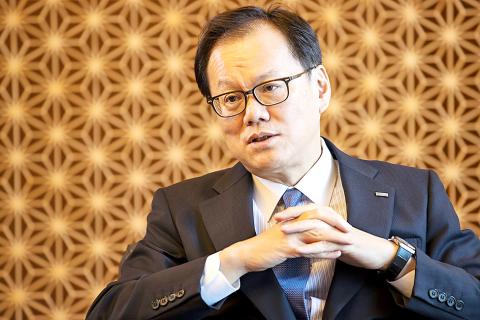Mizuho Financial Group Inc will pursue a digital route if it decides to follow its Japanese competitors into retail banking in Asia’s fast-growing emerging markets, chief executive officer Tatsufumi Sakai said.
Japan’s third-largest banking group is more likely to either buy an online lender or build one from scratch itself, rather than acquire banks with physical branches, Sakai said in an interview.
“We don’t intend to enter legacy consumer business at this point,” he said. “We’re more interested in a digital business model.”

Photo: Bloomberg
Japan’s biggest banks have made Asia their focus as persistently low interest rates and a sluggish economy hurt prospects at home.
Mizuho’s approach would mark a sharp contrast with Mitsubishi UFJ Financial Group Inc and Sumitomo Mitsui Financial Group Inc, which have spent billions of dollars acquiring traditional commercial lenders in Southeast Asia in recent years.
While Mizuho does not have any specific plans to get into retail banking in emerging Asia right now, the region has huge growth potential and a young population that is embracing digital technology for banking, Sakai said.
“The need for financial services will no doubt increase,” he said.
With the weakest capital ratio among the three Japanese banks, Mizuho has less room to make acquisitions of the scale that its rivals have achieved. At home, it is reducing its retail branch network and bolstering digital channels, according to a five-year business plan released last month.
Sakai, 59, also spoke of ambitions to expand transaction banking for corporate clients in Asia.
Handling more money transfers and cash flows for companies would allow the bank to boost its overseas deposits, providing a relatively cheap source of foreign-currency funding.
Mizuho and its rivals have been aggressively expanding overseas lending, which generates bigger margins than domestic loans.
“It’s important to secure as much as client deposit money as a stable funding source” to continue expanding lending abroad, Sakai said.
While there has been ample liquidity in the past three years, “we expect the funding environment will become tighter,” he said.
Sakai ruled out the idea of acquiring a US bank to expand Mizuho’s dollar deposits, given the costs of buying and integrating a local lender, along with regulatory issues.

CHIP RACE: Three years of overbroad export controls drove foreign competitors to pursue their own AI chips, and ‘cost US taxpayers billions of dollars,’ Nvidia said China has figured out the US strategy for allowing it to buy Nvidia Corp’s H200s and is rejecting the artificial intelligence (AI) chip in favor of domestically developed semiconductors, White House AI adviser David Sacks said, citing news reports. US President Donald Trump on Monday said that he would allow shipments of Nvidia’s H200 chips to China, part of an administration effort backed by Sacks to challenge Chinese tech champions such as Huawei Technologies Co (華為) by bringing US competition to their home market. On Friday, Sacks signaled that he was uncertain about whether that approach would work. “They’re rejecting our chips,” Sacks

Taiwan’s exports soared 56 percent year-on-year to an all-time high of US$64.05 billion last month, propelled by surging global demand for artificial intelligence (AI), high-performance computing and cloud service infrastructure, the Ministry of Finance said yesterday. Department of Statistics Director-General Beatrice Tsai (蔡美娜) called the figure an unexpected upside surprise, citing a wave of technology orders from overseas customers alongside the usual year-end shopping season for technology products. Growth is likely to remain strong this month, she said, projecting a 40 percent to 45 percent expansion on an annual basis. The outperformance could prompt the Directorate-General of Budget, Accounting and

NATIONAL SECURITY: Intel’s testing of ACM tools despite US government control ‘highlights egregious gaps in US technology protection policies,’ a former official said Chipmaker Intel Corp has tested chipmaking tools this year from a toolmaker with deep roots in China and two overseas units that were targeted by US sanctions, according to two sources with direct knowledge of the matter. Intel, which fended off calls for its CEO’s resignation from US President Donald Trump in August over his alleged ties to China, got the tools from ACM Research Inc, a Fremont, California-based producer of chipmaking equipment. Two of ACM’s units, based in Shanghai and South Korea, were among a number of firms barred last year from receiving US technology over claims they have

BARRIERS: Gudeng’s chairman said it was unlikely that the US could replicate Taiwan’s science parks in Arizona, given its strict immigration policies and cultural differences Gudeng Precision Industrial Co (家登), which supplies wafer pods to the world’s major semiconductor firms, yesterday said it is in no rush to set up production in the US due to high costs. The company supplies its customers through a warehouse in Arizona jointly operated by TSS Holdings Ltd (德鑫控股), a joint holding of Gudeng and 17 Taiwanese firms in the semiconductor supply chain, including specialty plastic compounds producer Nytex Composites Co (耐特) and automated material handling system supplier Symtek Automation Asia Co (迅得). While the company has long been exploring the feasibility of setting up production in the US to address